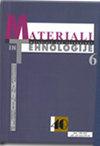EFFECT OF A SCANDIUM ADDITION ON ANODIZING AlMg ALLOYS
IF 0.8
4区 材料科学
Q4 MATERIALS SCIENCE, MULTIDISCIPLINARY
引用次数: 0
Abstract
Scandium (Sc) is known to be one of the most effective alloying elements of aluminum alloys. The only drawback is its high price, but that could change quickly due to the promising results of recent research on its extraction. However, the data on how it affects anodic oxidation are very scarce. In this research, we analyzed how a micro-addition of Sc to the AlMg alloy affects the growth mechanism and properties of the protective aluminium oxide layer depending on the anodization parameters. For comparison, alloy AA5083 with a similar magnesium content was also anodized with the same anodizing parameters. In all experiments, sulfuric acid (VI) with concentrations of 1.72 M or 2.2 M at temperatures of 21 °C or 35 °C was used as the electrolyte. Potentiostatic (18 V) and galvanostatic (20 mA/cm2) anodizing methods were applied. The results (SED-EDS) show that scandium is uniformly intercalated in the matrix of the oxide layer and decreases its resistivity, which increases the oxide growth rate during potentiostatic anodizing and decreases the pore density and pore diameters during galvanostatic anodizing. Moreover, it increases the mobility of cations through the oxide layer, thus accelerating the oxidation reaction in concentrated sulfuric acid electrolytes. On the other hand, the increased cation mobility considerably increases the sensitivity to the temperature of the electrolyte, which can change the growth mechanism of the oxide layer and thus its morphology.添加钪对铝合金阳极氧化的影响
钪(Sc)是已知的最有效的铝合金合金元素之一。唯一的缺点是它的价格高,但由于最近对其提取的研究取得了有希望的结果,这种情况可能很快就会改变。然而,关于它如何影响阳极氧化的数据非常少。在本研究中,我们分析了在AlMg合金中微量添加Sc对氧化铝保护层生长机理和性能的影响,以及阳极氧化参数的变化。为了比较,采用相同的阳极氧化参数对镁含量相近的合金AA5083进行了阳极氧化。在所有实验中,分别使用浓度为1.72 M和2.2 M,温度分别为21℃和35℃的硫酸(VI)作为电解液。采用恒电位(18 V)和恒流(20 mA/cm2)阳极氧化方法。结果(SED-EDS)表明,钪均匀嵌入到氧化层基体中,降低了氧化层的电阻率,提高了恒电位阳极氧化过程中氧化物的生长速率,降低了恒流阳极氧化过程中的孔隙密度和孔径。此外,它增加了阳离子通过氧化层的迁移率,从而加速了浓硫酸电解质中的氧化反应。另一方面,阳离子迁移率的增加大大增加了对电解质温度的敏感性,这可以改变氧化层的生长机制,从而改变其形态。
本文章由计算机程序翻译,如有差异,请以英文原文为准。
求助全文
约1分钟内获得全文
求助全文
来源期刊

Materiali in tehnologije
工程技术-材料科学:综合
CiteScore
1.30
自引率
0.00%
发文量
73
审稿时长
4-8 weeks
期刊介绍:
The journal MATERIALI IN TEHNOLOGIJE/MATERIALS AND TECHNOLOGY is a scientific journal, devoted to original papers and review scientific papers concerned with the areas of fundamental and applied science and technology. Topics of particular interest include metallic materials, inorganic materials, polymers, vacuum technique and lately nanomaterials.
 求助内容:
求助内容: 应助结果提醒方式:
应助结果提醒方式:


